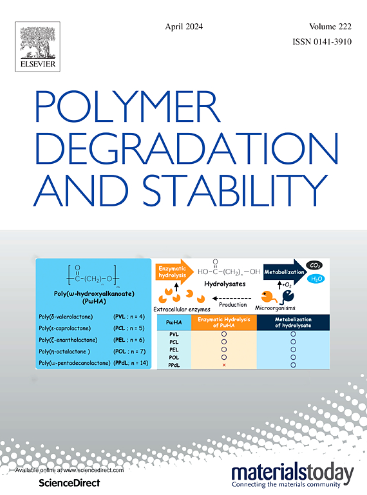Novel one-pot recovery and in-situ crystallization of polyhydroxybutyrate and hydroxyapatite/tricalcium phosphate biocomposite microparticles with comparative life cycle assessment
IF 6.3
2区 化学
Q1 POLYMER SCIENCE
引用次数: 0
Abstract
Formation of polyhydroxybutyrate (PHB) biopolymer composites with bioceramics such as hydroxyapatite (HA) and tricalcium phosphate (TCP) is essential in achieving mechanical properties needed for novel bone tissue engineering using PHB. However, composite microparticle synthesis typically requires multiple steps, including 1) PHB recovery and purification, 2) dispersion of HA and TCP particles in the melt or solvent-dissolved polymer liquid, and 3) micro-droplet drying. In this study, PHB/HA/TCP composite microparticles were successfully produced by one-pot biosynthesis. This was achieved during acid-based PHB recovery by utilizing the crystallization of native-amorphous granule PHB within Cupriavidus necator. In-situ PHB crystallization was successfully monitored by real-time attenuated total reflection-Fourier transform infrared (ATR-FTIR). Additionally, the in-situ crystallization behavior was elucidated by scanning electron microscopy (SEM) and transmission electron microscopy (TEM). The most suitable conditions for synthesis of the PHB/HA/TCP composite were pH 2, and 20 min of reaction time, which capitalizes on the amorphous nature of the in-situ PHB during recovery. The HA and TCP did not function as nucleating agents, thereby not impacting accumulation and homogeneity. This allows HA/TCP bioceramics to be inserted into the polymer during the PHB recovery period, and after the crystallization step is completed, the composite microparticles could facilely form. The crystallization mechanism was found to be sporadic, and the morphology was a disc with two dimensions. Additionally, the life cycle assessment (LCA) revealed that the one-pot method reduced global warming potential (GWP) emissions by 50% and non-renewable energy use (NREU) by a comparable margin, compared to the conventional multi-step method for HA/TCP (20:80) production. These findings emphasize the environmental advantages of the one-pot approach alongside its cost and process efficiency. The demonstrated one-pot synthesis method would allow for more streamlined and cost-effective production of PHB/HA/TCP biocomposites. The materials produced and insights gained will be beneficial for future development of biopolymer composite processing and biomedical applications.

聚羟基丁酸盐和羟基磷灰石/磷酸三钙生物复合微粒的新型一锅回收和原位结晶与比较生命周期评估
用羟基磷灰石(HA)和磷酸三钙(TCP)等生物陶瓷制备聚羟基丁酸酯(PHB)生物聚合物复合材料是实现新型骨组织工程所需力学性能的必要条件。然而,复合微粒的合成通常需要多个步骤,包括1)PHB的回收和纯化,2)HA和TCP颗粒在熔融或溶剂溶解聚合物液体中的分散,以及3)微滴干燥。本研究通过一锅法成功制备了PHB/HA/TCP复合微粒。这是在酸基PHB回收过程中,通过利用Cupriavidus necator内天然非晶颗粒PHB的结晶实现的。利用实时衰减全反射-傅里叶变换红外(ATR-FTIR)技术成功地监测了PHB的原位结晶。此外,通过扫描电镜(SEM)和透射电镜(TEM)分析了原位结晶行为。合成PHB/HA/TCP复合材料的最佳条件是pH为2,反应时间为20 min,这充分利用了原位PHB在回收过程中的无定形特性。HA和TCP不作为成核剂,因此不影响积累和均匀性。这使得HA/TCP生物陶瓷可以在PHB回收期间插入聚合物中,在结晶步骤完成后,复合微粒可以很容易地形成。结晶机制为偶发性,结晶形态为二维圆盘状。此外,生命周期评估(LCA)显示,与HA/TCP(20:8)生产的传统多步骤方法相比,一锅法减少了50%的全球变暖潜能值(GWP)排放和不可再生能源使用(NREU)。这些发现强调了一锅方法的环境优势以及它的成本和过程效率。所演示的一锅合成方法将使PHB/HA/TCP生物复合材料的生产更加简化和具有成本效益。所生产的材料和获得的见解将有利于生物聚合物复合材料加工和生物医学应用的未来发展。
本文章由计算机程序翻译,如有差异,请以英文原文为准。
求助全文
约1分钟内获得全文
求助全文
来源期刊

Polymer Degradation and Stability
化学-高分子科学
CiteScore
10.10
自引率
10.20%
发文量
325
审稿时长
23 days
期刊介绍:
Polymer Degradation and Stability deals with the degradation reactions and their control which are a major preoccupation of practitioners of the many and diverse aspects of modern polymer technology.
Deteriorative reactions occur during processing, when polymers are subjected to heat, oxygen and mechanical stress, and during the useful life of the materials when oxygen and sunlight are the most important degradative agencies. In more specialised applications, degradation may be induced by high energy radiation, ozone, atmospheric pollutants, mechanical stress, biological action, hydrolysis and many other influences. The mechanisms of these reactions and stabilisation processes must be understood if the technology and application of polymers are to continue to advance. The reporting of investigations of this kind is therefore a major function of this journal.
However there are also new developments in polymer technology in which degradation processes find positive applications. For example, photodegradable plastics are now available, the recycling of polymeric products will become increasingly important, degradation and combustion studies are involved in the definition of the fire hazards which are associated with polymeric materials and the microelectronics industry is vitally dependent upon polymer degradation in the manufacture of its circuitry. Polymer properties may also be improved by processes like curing and grafting, the chemistry of which can be closely related to that which causes physical deterioration in other circumstances.
 求助内容:
求助内容: 应助结果提醒方式:
应助结果提醒方式:


